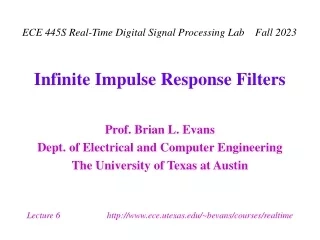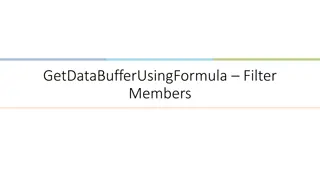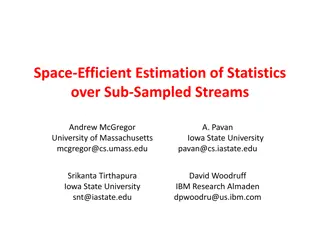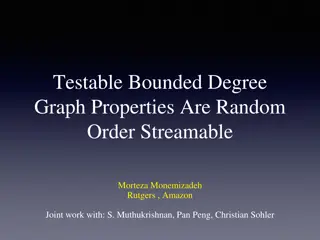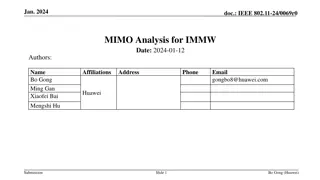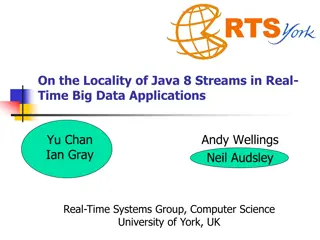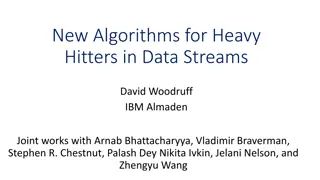More Algorithms for Data Streams: Filter, Count, and Estimate
advanced algorithms for processing data streams efficiently, including filtering with Bloom filters, counting distinct elements using Flajolet-Martin method, estimating moments with AMS method, and counting frequent items. Learn how to handle massive datasets without storing all elements in memory.
Download Presentation

Please find below an Image/Link to download the presentation.
The content on the website is provided AS IS for your information and personal use only. It may not be sold, licensed, or shared on other websites without obtaining consent from the author.If you encounter any issues during the download, it is possible that the publisher has removed the file from their server.
You are allowed to download the files provided on this website for personal or commercial use, subject to the condition that they are used lawfully. All files are the property of their respective owners.
The content on the website is provided AS IS for your information and personal use only. It may not be sold, licensed, or shared on other websites without obtaining consent from the author.
E N D
Presentation Transcript
Note to other teachers and users of these slides: We would be delighted if you found this our material useful in giving your own lectures. Feel free to use these slides verbatim, or to modify them to fit your own needs. If you make use of a significant portion of these slides in your own lecture, please include this message, or a link to our web site: http://www.mmds.org Mining of Massive Datasets Edited based onLeskovec sfromhttp://www.mmds.org
More algorithms for streams: (1) Filtering a data stream:Bloom filters Select elements with property x from stream (2) Counting distinct elements:Flajolet-Martin Number of distinct elements in the last k elements of the stream (3) Estimating moments:AMS method Estimate std. dev. of last k elements (4) Counting frequent items J. Leskovec, A. Rajaraman, J. Ullman: Mining of Massive Datasets, http://www.mmds.org 2
Each element of data stream is a tuple Given a list of keys S Determine which tuples of stream are in S Obvious solution: Hash table But suppose we do not have enough memory to store all of S in a hash table E.g., we might be processing millions of filters on the same stream J. Leskovec, A. Rajaraman, J. Ullman: Mining of Massive Datasets, http://www.mmds.org 4
Example: Email spam filtering We know 1 billion good email addresses If an email comes from one of these, it is NOT spam Publish-subscribe systems You are collecting lots of messages (news articles) People express interest in certain sets of keywords Determine whether each message matches user s interest J. Leskovec, A. Rajaraman, J. Ullman: Mining of Massive Datasets, http://www.mmds.org 5
Given a set of keys S that we want to filter Create a bit array B of n bits, initially all 0s Choose a hash function h with range [0,n) Hash each member of s S to one of n buckets, and set that bit to 1, i.e., B[h(s)]=1 Hash each element a of the stream and output only those that hash to bit that was set to 1 Output a if B[h(a)] == 1 J. Leskovec, A. Rajaraman, J. Ullman: Mining of Massive Datasets, http://www.mmds.org 6
Output the item since it may be in S. Item hashes to a bucket that at least one of the items in S hashed to. Item Hash func h 0010001011000 Bit array B Drop the item. It hashes to a bucket set to 0 so it is surely not inS. Creates false positives but no false negatives If the item is in S we surely output it, if not we may still output it J. Leskovec, A. Rajaraman, J. Ullman: Mining of Massive Datasets, http://www.mmds.org 7
|S| = 1 billion email addresses |B|= 1GB = 8 billion bits If the email address is in S, then it surely hashes to a bucket that has the big set to 1, so it always gets through (no false negatives) Approximately 1/8 of the bits are set to 1, so about 1/8th of the addresses not in Sget through to the output (false positives) Actually, less than 1/8th, because more than one address might hash to the same bit J. Leskovec, A. Rajaraman, J. Ullman: Mining of Massive Datasets, http://www.mmds.org 8
More accurate analysis for the number of false positives Consider: If we throw m darts into nequally likely targets, what is the probability that a target gets at least one dart? In our case: Targets = bits/buckets Darts = hash values of items J. Leskovec, A. Rajaraman, J. Ullman: Mining of Massive Datasets, http://www.mmds.org 9
We have m darts,n targets What is the probability that a target gets at least one dart? Equals 1/e as n Equivalent / n) m n( 1 - (1 1/n) 1 e m/n Probability some target X not hit by a dart Probability at least one dart hits target X J. Leskovec, A. Rajaraman, J. Ullman: Mining of Massive Datasets, http://www.mmds.org 10
Fraction of 1s in the array B= = probability of false positive=1 e-m/n Example:109 darts, 8 109 targets Fraction of 1s in B = 1 e-1/8 = 0.1175 Compare with our earlier estimate: 1/8 = 0.125 J. Leskovec, A. Rajaraman, J. Ullman: Mining of Massive Datasets, http://www.mmds.org 11
Consider: |S| = m, |B| = n Use k independent hash functions h1 , , hk Initialization: Set B to all 0s Hash each element s S using each hash function hi, set B[hi(s)] = 1 (for each i = 1,.., k) Run-time: When a stream element with key x arrives If B[hi(x)] = 1for alli = 1,..., k then declare that x is inS That is, x hashes to a bucket set to 1 for every hash function hi(x) Otherwise discard the element x (note: we have a single array B!) J. Leskovec, A. Rajaraman, J. Ullman: Mining of Massive Datasets, http://www.mmds.org 12
What fraction of the bit vector B are 1s? Throwing k m darts at n targets So fraction of 1s is (1 e-km/n) But we havek independent hash functions and we only let the element x through if all k hash element x to a bucket of value 1 So, false positive probability= (1 e-km/n)k J. Leskovec, A. Rajaraman, J. Ullman: Mining of Massive Datasets, http://www.mmds.org 13
0.2 m = 1 billion, n = 8 billion k = 1: (1 e-1/8) = 0.1175 k = 2: (1 e-1/4)2 = 0.0493 0.18 0.16 False positive prob. 0.14 0.12 0.1 0.08 What happens as we keep increasing k? 0.06 0.04 0.02 0 2 Number of hash functions, k 4 6 8 10 12 14 16 18 20 Optimal value ofk:n/m ln(2) In our case: Optimal k =8 ln(2) = 5.54 6 Error at k = 6: (1 e-1/6)2 = 0.0235 J. Leskovec, A. Rajaraman, J. Ullman: Mining of Massive Datasets, http://www.mmds.org 14
Bloom filters guarantee no false negatives, and use limited memory Great for pre-processing before more expensive checks Suitable for hardware implementation Hash function computations can be parallelized Is it better to have 1 big B or k small Bs? It is the same: (1 e-km/n)k vs. (1 e-m/(n/k))k But keeping 1 big B is simpler J. Leskovec, A. Rajaraman, J. Ullman: Mining of Massive Datasets, http://www.mmds.org 15
Problem: Data stream consists of a universe of elements chosen from a set of size N Maintain a count of the number of distinct elements seen so far Obvious approach: Maintain the set of elements seen so far That is, keep a hash table of all the distinct elements seen so far J. Leskovec, A. Rajaraman, J. Ullman: Mining of Massive Datasets, http://www.mmds.org 17
How many different words are found among the Web pages being crawled at a site? Unusually low or high numbers could indicate artificial pages (spam?) How many different Web pages does each customer request in a week? How many distinct products have we sold in the last week? J. Leskovec, A. Rajaraman, J. Ullman: Mining of Massive Datasets, http://www.mmds.org 18
Real problem: What if we do not have space to maintain the set of elements seen so far? Estimate the count in an unbiased way Accept that the count may have a little error, but limit the probability that the error is large J. Leskovec, A. Rajaraman, J. Ullman: Mining of Massive Datasets, http://www.mmds.org 19
Pick a hash function h that maps each of the Nelements to at least log2 Nbits For each stream element a, let r(a) be the number of trailing 0s in h(a) r(a) = position of first 1 counting from the right E.g., say h(a) = 12, then 12 is 1100 in binary, sor(a) = 2 Record R = the maximum r(a) seen R = maxa r(a), over all the items a seen so far Estimated number of distinct elements = 2R J. Leskovec, A. Rajaraman, J. Ullman: Mining of Massive Datasets, http://www.mmds.org 20
Very very rough and heuristic intuition why Flajolet-Martin works: h(a) hashesa with equal prob. to any of N values Then h(a) is a sequence of log2 N bits, where 2-rfraction of all as have a tail of r zeros About 50% ofas hash to ***0 About 25% ofas hash to **00 So, if we saw the longest tail of r=2 (i.e., item hash ending *100) then we have probably seen about4 distinct items so far So, it takes to hash about 2r items before we see one with zero-suffix of length r J. Leskovec, A. Rajaraman, J. Ullman: Mining of Massive Datasets, http://www.mmds.org 21
Now we show why Flajolet-Martin works Formally, we will show that probability of finding a tail of r zeros: Goes to 1 if ? ?? Goes to 0 if ? ?? where ? is the number of distinct elements seen so far in the stream Thus, 2R will almost always be around m! J. Leskovec, A. Rajaraman, J. Ullman: Mining of Massive Datasets, http://www.mmds.org 22
What is the probability that a given h(a) ends in at least r zeros is 2-r h(a) hashes elements uniformly at random Probability that a random number ends in at least rzeros is 2-r Then, the probability of NOT seeing a tail of length r among m elements: ? ? ? ? Prob. that given h(a) ends in fewer than r zeros Prob. all end in fewer than r zeros. J. Leskovec, A. Rajaraman, J. Ullman: Mining of Massive Datasets, http://www.mmds.org 23
) 2 1 ( ) 2 1 ( r r r r m m m r 2 e = ) 2 ( 2 r r r = 2) ( 2 ) 2 r m r m m 1 ( 2 ) 1 ( 2 e Note: Prob. of NOT finding a tail of length r is: If m << 2r, then prob. tends to 1 as m/2r So, the probability of finding a tail of length r tends to 0 If m >> 2r, then prob. tends to 0 as m/2r So, the probability of finding a tail of lengthr tends to 1 r = 2 r m m 0 1 ( 2 ) 1 e r = 2 r m m 1 ( 2 ) 0 e Thus, 2R will almost always be around m! J. Leskovec, A. Rajaraman, J. Ullman: Mining of Massive Datasets, http://www.mmds.org 24
E[2R] is actually infinite Probability halves when R Workaround involves using many hash functions hiand getting many samples of Ri How are samples Ri combined? Average? What if one very large value ???? Median? All estimates are a power of 2 Solution: Partition your samples into small groups Take the median of groups Then take the average of the medians J. Leskovec, A. Rajaraman, J. Ullman: Mining of Massive Datasets, http://www.mmds.org R+1, but value doubles 25
Suppose a stream has elements chosen from a set A of N values Let mi be the number of times value i occurs in the stream The kth moment is A k i m ) ( i J. Leskovec, A. Rajaraman, J. Ullman: Mining of Massive Datasets, http://www.mmds.org 27
A k i m ) ( i 0thmoment = number of distinct elements The problem just considered 1st moment = count of the numbers of elements = length of the stream Easy to compute 2nd moment = surprise number S = a measure of how uneven the distribution is J. Leskovec, A. Rajaraman, J. Ullman: Mining of Massive Datasets, http://www.mmds.org 28
Stream of length 100 11 distinct values Item counts: 10, 9, 9, 9, 9, 9, 9, 9, 9, 9, 9 Surprise S = 910 Item counts: 90, 1, 1, 1, 1, 1, 1, 1 ,1, 1, 1 Surprise S = 8,110 J. Leskovec, A. Rajaraman, J. Ullman: Mining of Massive Datasets, http://www.mmds.org 29
[Alon, Matias, and Szegedy] AMS method works for all moments Gives an unbiased estimate We will just concentrate on the 2nd moment S We pick and keep track of many variables X: For each variable X we store X.el and X.val X.el corresponds to the item i X.val corresponds to the count of item i Note this requires a count in main memory, so number of Xs is limited Our goal is to compute ? = ??? ? J. Leskovec, A. Rajaraman, J. Ullman: Mining of Massive Datasets, http://www.mmds.org 30
How to set X.val and X.el? Assume stream has length n (we relax this later) Pick some random time t (t<n) to start, so that any time is equally likely Let at time t the stream have item i. We setX.el = i Then we maintain count c (X.val = c) of the number of is in the stream starting from the chosen time t Then the estimate of the 2nd moment ( ??? ? = ?(?) = ? (? ? ?) Note, we will keep track of multiple Xs, (X1, X2, Xk) and our final estimate will be? = ?/? ? ?) is: ??(??) J. Leskovec, A. Rajaraman, J. Ullman: Mining of Massive Datasets, http://www.mmds.org 31
1 2 ma 3 Count: Stream: a a b b b a b a ? 2nd moment is ? = ??? ct number of times item at time t appears from time t onwards (c1=ma , c2=ma-1, c3=mb) ? ?(?) =? ? ?=? ?(??? ?) =? ? ?? (? + ? + ? + + ??? ?) ? mi total count of item i in the stream (we are assuming stream has length n) Time t when the penultimate iis seen (ct=2) Time t when the first i is seen (ct=mi) Time t when the last i is seen (ct=1) Group times by the value seen J. Leskovec, A. Rajaraman, J. Ullman: Mining of Massive Datasets, http://www.mmds.org 32
1 2 ma 3 Count: Stream: a a b b b a b a 1 ? ?? (1 + 3 + 5 + + 2?? 1) Little side calculation: 1 + 3 + 5 + + 2?? 1 = ?=1 2 Then ? ?(?) =? ? ? ? ?? ? ?(?) = ??(2? 1) = 2????+1 ??= (??)2 ? ?= ? So, ? ?(?) = ??? We have the second moment (in expectation)! J. Leskovec, A. Rajaraman, J. Ullman: Mining of Massive Datasets, http://www.mmds.org 33
For estimating kth moment we essentially use the same algorithm but change the estimate: For k=2 we used n (2 c 1) For k=3 we use: n (3 c2 3c + 1) (where c=X.val) Why? For k=2: Remember we had 1 + 3 + 5 + + 2?? 1 and we showed terms 2c-1 (for c=1, ,m) sum to m2 ?=1 2? 1 = ?=1 ?2 ?=1 So:?? ? = ?? ? ?? For k=3:c3 - (c-1)3= 3c2 - 3c + 1 Generally: Estimate = ? (?? ? 1?) ? ? ? ? 12=?2 J. Leskovec, A. Rajaraman, J. Ullman: Mining of Massive Datasets, http://www.mmds.org 34
In practice: Compute ?(?) = ?(? ? ?) for as many variables X as you can fit in memory Average them in groups Take median of averages Problem: Streams never end We assumed there was a number n, the number of positions in the stream But real streams go on forever, so n is a variable the number of inputs seen so far J. Leskovec, A. Rajaraman, J. Ullman: Mining of Massive Datasets, http://www.mmds.org 35
(1) The variablesX have n as a factor keep n separately; just hold the count in X (2) Suppose we can only store kcounts. We must throw some Xs out as time goes on: Objective: Each starting time t is selected with probability k/n Solution: (fixed-size sampling!) Choose the first k times for k variables When the nth element arrives (n > k), choose it with probability k/n If you choose it, throw one of the previously stored variables X out, with equal probability J. Leskovec, A. Rajaraman, J. Ullman: Mining of Massive Datasets, http://www.mmds.org 36
New Problem: Given a stream, which items appear more than s times in the window? Possible solution: Think of the stream of baskets as one binary stream per item 1 = item present; 0 = not present Use DGIM to estimate counts of 1s for all items 6 10 4 3 2 2 1 1 0 0 1 0 0 1 1 1 0 0 0 1 0 1 0 0 1 0 0 0 1 0 1 1 0 1 1 0 1 1 1 0 0 1 0 1 0 1 1 0 0 1 1 0 1 0 N J. Leskovec, A. Rajaraman, J. Ullman: Mining of Massive Datasets, http://www.mmds.org 38
In principle, you could count frequent pairs or even larger sets the same way One stream per itemset Drawbacks: Only approximate Number of itemsets is way too big J. Leskovec, A. Rajaraman, J. Ullman: Mining of Massive Datasets, http://www.mmds.org 39
Exponentially decaying windows: A heuristic for selecting likely frequent item(sets) What are currently most popular movies? Instead of computing the raw count in last N elements Compute a smooth aggregation over the whole stream If stream is a1, a2, and we are taking the sum of the stream, take the answer at time t to be: = ?=? ??? ?? ? c is a constant, presumably tiny, like 10-6 or 10-9 When new at+1 arrives: Multiply current sum by (1-c) and add at+1 J. Leskovec, A. Rajaraman, J. Ullman: Mining of Massive Datasets, http://www.mmds.org ? 40
If each aiis an item we can compute the characteristic function of each possible item xas an Exponentially Decaying Window That is: ?=? ?? ? ?? ? where i=1 if ai=x, and 0 otherwise Imagine that for each item xwe have a binary stream (1 ifx appears, 0 ifx does not appear) New item x arrives: Multiply all counts by (1-c) Add +1 to count for element x Call this sum the weight of item x ? J. Leskovec, A. Rajaraman, J. Ullman: Mining of Massive Datasets, http://www.mmds.org 41
. . . 1/c Important property: Sum over all weights ?? ?? is 1/[1 (1 c)] = 1/c J. Leskovec, A. Rajaraman, J. Ullman: Mining of Massive Datasets, http://www.mmds.org 42
What are currently most popular movies? Suppose we want to find movies of weight > Important property: Sum over all weights ?1 ?? is 1/[1 (1 c)] = 1/c Thus: There cannot be more than 2/c movies with weight of or more So, 2/c is a limit on the number of movies being counted at any time J. Leskovec, A. Rajaraman, J. Ullman: Mining of Massive Datasets, http://www.mmds.org 43
Count (some) itemsets in an E.D.W. What are currently hot itemsets? Problem: Too many itemsets to keep counts of all of them in memory When a basket B comes in: Multiply all counts by (1-c) For uncounted items in B, create new count Add 1 to count of any item in B and to any itemset contained in B that is already being counted Drop counts < Initiate new counts (next slide) J. Leskovec, A. Rajaraman, J. Ullman: Mining of Massive Datasets, http://www.mmds.org 44
Start a count for an itemset S Bif every proper subset of Shad a count prior to arrival of basketB Intuitively: If all subsets of S are being counted this means they are frequent/hot and thus Shas a potential to be hot Example: Start counting S={i, j} iff both i and j were counted prior to seeing B Start counting S={i, j, k} iff {i, j}, {i, k}, and {j, k} were all counted prior to seeing B J. Leskovec, A. Rajaraman, J. Ullman: Mining of Massive Datasets, http://www.mmds.org 45
Counts for single items < (2/c)(avg. number of items in a basket) Counts for larger itemsets = ?? But we are conservative about starting counts of large sets If we counted every set we saw, one basket of 20 items would initiate 1M counts J. Leskovec, A. Rajaraman, J. Ullman: Mining of Massive Datasets, http://www.mmds.org 46


